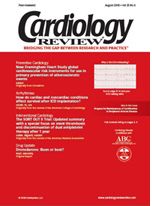Publication
Article
Cardiology Review® Online
Predicting outcome based on myocardial injury monitoring
A 47-year-old man with an 8-year history of chronic heart failure (CHF) as a result of idiopathic dilated cardiomyopathy had been hospitalized for worsening heart failure once in the past year. He remained as an outpatient in New York Heart Association (NYHA) functional class II and was taking 10 mg enalapril (Vasotec) twice a day, 25 mg carvedilol (Coreg) twice a day, 40 mg furosemide (Lasix) once a day, 0.125 mg digoxin (Lanoxin) once a day, 12.5 mg hydrochlorothiazide (Hydrodiuril, Microzide) once a day, 200 mg amiodarone (Cordarone) once a day, and 12.5 mg spironolactone (Aldactone) once a day. Results of the clinical examination showed a blood pressure of 110/70 mm Hg, a heart rate of 59 beats per minute, and a displaced apex with S3 systolic murmur attributable to mild-to-moderate mitral regurgitation, with no sign of
volume overload. The electrocardio-gram showed sinus rhythm, with left bundle branch block. Laboratory tests showed the following results: hematocrit, 47%; blood glucose, 96 mg/dL; potassium, 3.9 mEq/L; sodium, 136 mEq/L; creatinine, 1.3 mg/dL; and troponin T concentration (cTnT), 0.038 ng/dL. A two-dimensional echocardiogram showed that the patient had a left ventricular end-diastolic diameter of 86 mm and a left ventricular ejection fraction (LVEF) of 28%. The patient walked 420 meters on the 6-minute walk test. The changes in NYHA functional class, as well as cTnT, LVEF, and the 6-minute walk test during the follow-up period are shown in the Table.
Four months later, the patient was hospitalized for 5 days because of worsening heart failure. Between months
6 and 12, he required frequent hospital readmission, and his functional
status progressed to class III. Ventricular fibrillation was induced in an electrophysiological test, and an automatic implantable cardioverter defibrillator with resynchronization was implanted. He felt better for 2 months, but then his clinical condition deteriorated, and he was frequently hospitalized for refractory volume overload. An intra-aortic balloon pump was inserted, and he was urgently listed for heart transplantation. After a 30-day period, he successfully underwent cardiac transplantation.
This case emphasizes the prognostic value of cTnT monitoring in out-patients with clinically stable severe CHF. High levels of cTnT proceeded to clinical deterioration, even before functional decline and morphologic changes. Identification of such high-risk patients may result in earlier selection for other therapeutic options, including heart transplantation.
